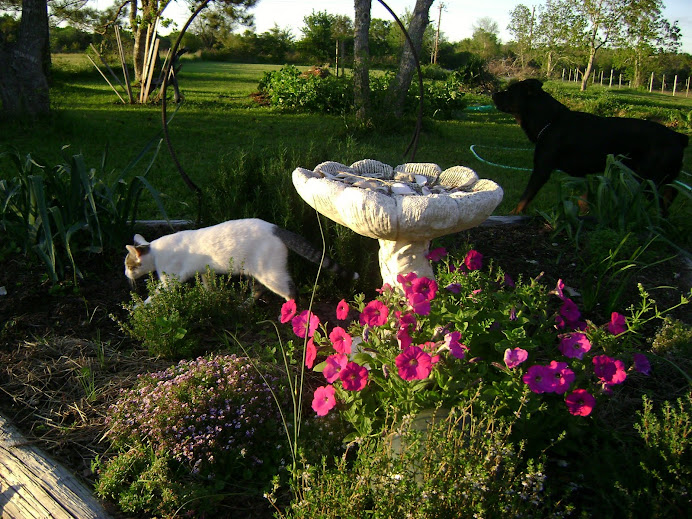Lemon Balm (Melissa officinalis)
It's a good thing that I had decided to grow the Lemon Balm in partial shade. It can really suffer in our soaring summer temperatures. But it bounces right back in the fall as the temperatures cool.
I've found that Lemon Balm really appreciates growing under some sort of canopy here in the south.
I've added many canopies of castor bean trees, cannas and hibiscus to help control the environment for many herbs to grow beneath. All three of these canopies seem to reach the perfect height at just the right time needed.
As a special note, all three of my canopy choices both release beneficial enzymes that help improve the soil as well as absorb unwanted matter such as possible salts.
The Lemon Balm thrives growing in and near my grapevines as well. I've found it to be a perfect companion plant for them.
Once Lemon Balm becomes well established, it begins to form a very nice ground cover if planted thickly. This has helped tremendously with keeping unwanted weeds choked out.
One of the best parts about this herb is that is stays green all winter long here. It holds up to the cold quite well during frost and light freeze.
It's important to keep Lemon Balm well mulched. As in most permacultural gardens the key is creating a natural forest floor.
It is in this way that little water is consumed because the moisture is better retained. That is very important, especially since we have experienced severe droughts for several years in a row.
Since Lemon Balm (Melissa Officinalis) is one of the members of the mint family, it appreciates a little water like most mints do.
Using Lemon Balm in a vinegar infusion aides our culinary kitchen as well as the medicine chest with its beneficial properties.
Being very high in vitamin C and Thiamin, Lemon Balm is also rich with flavonoids that take on antioxidant effects.
The best part is that this herb is very lemony, tart and sweet! That makes it quite pleasing to consume.
By making a vinegar infusion I have something handy in the kitchen for spritzing greens from the garden. It makes a great addition to marinades as well.
Lemon Balm also contains tannins that are important for the medicine chest. The tannins are astringents and have antiviral benefits.
As an infusion the astringent value will help heal bites and stings and keep from infection. It works great when dabbed on the skin with cotton to ease sunburns as well.
To make your vinegar infusion be sure to start with a sterile bottle. Do not use anything with metal, as in lids and caps.
Roll the herbs leaves on the counter to help release its oils. Chopped and tare the leaves and fill the bottle. Boil enough vinegar to fill the container, leaving enough head space to cork or plug. Be sure to use a non reactive pot when boiling.
Set it up in a cool dark place for at least 3 weeks. Swirl the bottle a bit every couple of days to keep it releasing the oils for better potency.
After this time simply strain it and refill the bottle. I always like to add a new sprig back to the bottle because they make it beautiful. I especially love to find a spring with some flowers for a finishing touch.
Happy Gardening!
Pammy





















.jpg)



















I have lemon balm in the garden, but have never really done anything with it. The vinegar infusion sounds like a good idea.
ReplyDeleteHi Tracey! I need to come by and visit again! I always love hearing from you! xo
Delete